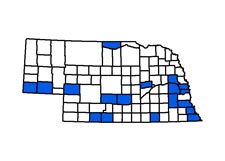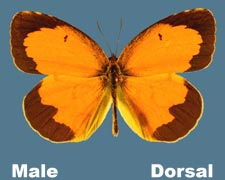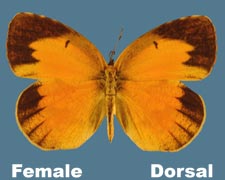
Sleepy Orange |
 |
| Abaeis nicippe (Cramer, 1779) |
| Status: Uncommon resident/stray |
| Flight Period(s): Flies entire year in the southern United States. In Nebraska the species has been recorded from 18 April – 27 August. Females arriving in the spring have produced two to three additional broods. |
| Range: A resident in the southern United from whence it strays north to southern Nevada and Utah in the west and the New England states in the east. In Nebraska it is most often encountered in the southern half of the state, although it has been found in Keya Paha County in the far north. |
| Larval Hostplant(s): Various legumes, including Partridge Pea and Wild Senna (Cassia fasciculata and C. marilandica), Hog Peanut (Amphicarpa bracteata) and Illinois Bundleflower (Desmanthus illinoensis), but probably preferring the Cassia species. |
| Overwinter: As pupae, but not surviving harsh winters. It appears that on occasion a pupa or two in a sheltered area sometimes survive a favorable Nebraska winter. On such occasions early flying adults are on the wing before their larval hostplants sprout. They perish without laying eggs and have no bearing on numbers later in the summer. |
| Commentary/Habitat: Contrary to its name, the Sleepy Orange is quite active. Adults do pause to take nectar and are also gather at mud to take water and minerals. Isolated populations resulting from a single female peak in numbers in the first generation, and although two more generations may follow the population decreases in numbers. It is unknown whether this is due to inbreeding or a decline in the quality of the hostplant later in the summer. |
| Similar Species: The other small sulphurs contain minimal or no orange coloration. The Orange Sulphur has silver cellspots on its ventral hindwing. |

